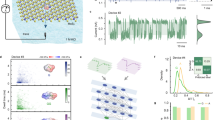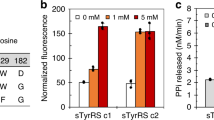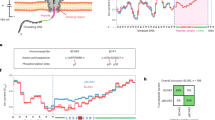Abstract
Sulfation is considered the most prevalent post-translational modification (PTM) on tyrosine; however, its importance is frequently undervalued due to difficulties in direct and unambiguous determination from phosphorylation. Here we present a sequence-independent strategy to directly map and quantify the tyrosine sulfation states in universal native peptides using an engineered protein nanopore. Molecular dynamics simulations and nanopore mutations reveal specific interactions between tyrosine sulfation and the engineered nanopore, dominating identification across diverse peptide sequences. We show a nanopore framework to discover tyrosine sulfation in unknown peptide fragments digested from a native protein and determine the sequence of the sulfated fragment based on current blockade enhancement induced by sulfation. Moreover, our method allows direct observation of peptide sulfation in ultra-low abundance, down to 1%, and distinguishes it from isobaric phosphorylation. This sequence-independent strategy suggests the potential of nanopore to explore specific PTMs in real-life samples and at the omics level.

This is a preview of subscription content, access via your institution
Access options
Access Nature and 54 other Nature Portfolio journals
Get Nature+, our best-value online-access subscription
27,99 € / 30 days
cancel any time
Subscribe to this journal
Receive 12 print issues and online access
269,00 € per year
only 22,42 € per issue
Buy this article
- Purchase on SpringerLink
- Instant access to full article PDF
Prices may be subject to local taxes which are calculated during checkout





Similar content being viewed by others
Data availability
Data supporting the findings of this study are available in the main text and the Supplementary Information. Additional raw data and the aerolysin cryo-EM structure are available at figshare (https://doi.org/10.6084/m9.figshare.26494222). Source data are provided with this paper.
References
Bettelheim, F. R. Tyrosine-O-sulfate in a peptide from fibrinogen. J. Am. Chem. Soc. 76, 2838–2839 (1954).
Baeuerle, P. A. & Huttner, W. B. Tyrosine sulfation is a trans-Golgi-specific protein modification. J. Cell Biol. 105, 2655–2664 (1987).
Pouyani, T. & Seed, B. PSGL-1 recognition of P-selectin is controlled by a tyrosine sulfation consensus at the PSGL-1 amino terminus. Cell 83, 333–343 (1995).
Sako, D. et al. A sulfated peptide segment at the amino terminus of PSGL-1 is critical for P-selectin binding. Cell 83, 323–331 (1995).
Lee, S.-W. et al. A type I–secreted, sulfated peptide triggers XA21-mediated innate immunity. Science 326, 850–853 (2009).
Thompson, R. E. et al. Tyrosine sulfation modulates activity of tick-derived thrombin inhibitors. Nat. Chem. 9, 909–917 (2017).
Xu, P., Cai, X., Guan, X. & Xie, W. Sulfoconjugation of protein peptides and glycoproteins in physiology and diseases. Pharmacol. Ther. 251, 108540 (2023).
Maxwell, J. W., Hawkins, P. M., Watson, E. E. & Payne, R. J. Exploiting chemical protein synthesis to study the role of tyrosine sulfation on anticoagulants from hematophagous organisms. Acc. Chem. Res. 56, 909–917 (2023).
Huttner, W. B. Tyrosine sulfation and the secretory pathway. Annu. Rev. Physiol. 50, 363–376 (1988).
Bashyal, A. & Brodbelt, J. S. Uncommon posttranslational modifications in proteomics: ADP‐ribosylation, tyrosine nitration, and tyrosine sulfation. Mass Spectrom. Rev. 43, 289–326 (2024).
Maxwell, J. W. & Payne, R. J. Revealing the functional roles of tyrosine sulfation using synthetic sulfopeptides and sulfoproteins. Curr. Opin. Chem. Biol. 58, 72–85 (2020).
Li, J. & Zhan, X. Mass spectrometry analysis of phosphotyrosine‐containing proteins. Mass Spectrom. Rev. 43, 857–887 (2024).
Alseekh, S. et al. Mass spectrometry-based metabolomics: a guide for annotation, quantification and best reporting practices. Nat. Methods 18, 747–756 (2021).
Yu, Y., Hoffhines, A. J., Moore, K. L. & Leary, J. A. Determination of the sites of tyrosine O-sulfation in peptides and proteins. Nat. Methods 4, 583–588 (2007).
Witze, E. S., Old, W. M., Resing, K. A. & Ahn, N. G. Mapping protein post-translational modifications with mass spectrometry. Nat. Methods 4, 798–806 (2007).
Hoffhines, A. J., Damoc, E., Bridges, K. G., Leary, J. A. & Moore, K. L. Detection and purification of tyrosine-sulfated proteins using a novel anti-sulfotyrosine monoclonal antibody. J. Biol. Chem. 281, 37877–37887 (2006).
Kasianowicz, J. J., Brandin, E., Branton, D. & Deamer, D. W. Characterization of individual polynucleotide molecules using a membrane channel. Proc. Natl Acad. Sci. USA 93, 13770–13773 (1996).
Rosen, C. B., Rodriguez-Larrea, D. & Bayley, H. Single-molecule site-specific detection of protein phosphorylation with a nanopore. Nat. Biotechnol. 32, 179–181 (2014).
Li, S. et al. T232K/K238Q aerolysin nanopore for mapping adjacent phosphorylation sites of a single tau peptide. Small Methods 4, 2000014 (2020).
Versloot, R. C. A. et al. Quantification of protein glycosylation using nanopores. Nano Lett. 22, 5357–5364 (2022).
Ensslen, T., Sarthak, K., Aksimentiev, A. & Behrends, J. C. Resolving isomeric posttranslational modifications using a biological nanopore as a sensor of molecular shape. J. Am. Chem. Soc. 144, 16060–16068 (2022).
Brinkerhoff, H., Kang, A. S., Liu, J., Aksimentiev, A. & Dekker, C. Multiple rereads of single proteins at single–amino acid resolution using nanopores. Science 374, 1509–1513 (2021).
Wang, K. et al. Unambiguous discrimination of all 20 proteinogenic amino acids and their modifications by nanopore. Nat. Methods 21, 92–101 (2023).
Nova, I. C. et al. Detection of phosphorylation post-translational modifications along single peptides with nanopores. Nat. Biotechnol. 42, 710–714 (2024).
Jiang, J. et al. Protein nanopore reveals the renin–angiotensin system crosstalk with single-amino-acid resolution. Nat. Chem. 15, 578–586 (2023).
Martin-Baniandres, P. et al. Enzyme-less nanopore detection of post-translational modifications within long polypeptides. Nat. Nanotechnol. 18, 1335–1340 (2023).
Zhang, M. et al. Real-time detection of 20 amino acids and discrimination of pathologically relevant peptides with functionalized nanopore. Nat. Methods 21, 609–618 (2024).
Li, M.-Y. et al. Revisiting the origin of nanopore current blockage for volume difference sensing at the atomic level. JACS Au 1, 967–976 (2021).
Schall, T. J. & Proudfoot, A. E. Overcoming hurdles in developing successful drugs targeting chemokine receptors. Nat. Rev. Immunol. 11, 355–363 (2011).
Niu, H., Li, M.-Y., Ying, Y.-L. & Long, Y.-T. An engineered third electrostatic constriction of aerolysin to manipulate heterogeneously charged peptide transport. Chem. Sci. 13, 2456–2461 (2022).
Li, J.-G. et al. Full width at half maximum of nanopore current blockage controlled by a single-biomolecule interface. Langmuir 38, 1188–1193 (2022).
Phillips, J. C. et al. Scalable molecular dynamics with NAMD. J. Comput. Chem. 26, 1781–1802 (2005).
Jumper, J. et al. Highly accurate protein structure prediction with AlphaFold. Nature 596, 583–589 (2021).
Ouldali, H. et al. Electrical recognition of the twenty proteinogenic amino acids using an aerolysin nanopore. Nat. Biotechnol. 38, 176–181 (2020).
Sauciuc, A., Morozzo della Rocca, B., Tadema, M. J., Chinappi, M. & Maglia, G. Translocation of linearized full-length proteins through an engineered nanopore under opposing electrophoretic force. Nat. Biotechnol. 42, 1275–1281 (2023).
Pastoriza-Gallego, M. et al. Dynamics of unfolded protein transport through an aerolysin pore. J. Am. Chem. Soc. 133, 2923–2931 (2011).
Meller, A., Nivon, L. & Branton, D. Voltage-driven DNA translocations through a nanopore. Phys. Rev. Lett. 86, 3435 (2001).
Seibert, C., Cadene, M., Sanfiz, A., Chait, B. T. & Sakmar, T. P. Tyrosine sulfation of CCR5 N-terminal peptide by tyrosylprotein sulfotransferases 1 and 2 follows a discrete pattern and temporal sequence. Proc. Natl Acad. Sci. USA 99, 11031–11036 (2002).
Yu, W. et al. Histone tyrosine sulfation by SULT1B1 regulates H4R3me2a and gene transcription. Nat. Chem. Biol. 19, 855–864 (2023).
Talaga, D. S. & Li, J. Single-molecule protein unfolding in solid state nanopores. J. Am. Chem. Soc. 131, 9287–9297 (2009).
Mehta, A. Y., Heimburg-Molinaro, J., Cummings, R. D. & Goth, C. K. Emerging patterns of tyrosine sulfation and O-glycosylation cross-talk and co-localization. Curr. Opin. Struct. Biol. 62, 102–111 (2020).
Humphrey, W., Dalke, A., Schulten, K. & VMD Visual molecular dynamics. J. Mol. Graph. 14, 33–38 (1996).
Yang, Y., Liang, M., Wang, R. & He, C. Chemical protein synthesis elucidates key modulation mechanism of the tyrosine-O-sulfation in inducing strengthened inhibitory activity of hirudin. Chin. Chem. Lett. 34, 107806 (2023).
Wu, X.-Y. et al. Precise construction and tuning of an aerolysin single-biomolecule interface for single-molecule sensing. CCS Chem. 1, 304–312 (2019).
Liu, S.-C. & Long, Y.-T. PyNanoLab. Zenodo https://doi.org/10.5281/zenodo.11383973 (2019).
Iacovache, I. et al. Cryo-EM structure of aerolysin variants reveals a novel protein fold and the pore-formation process. Nat. Commun. 7, 12062 (2016).
Jorgensen, W. L., Chandrasekhar, J., Madura, J. D., Impey, R. W. & Klein, M. L. Comparison of simple potential functions for simulating liquid water. J. Chem. Phys. 79, 926–935 (1983).
Humphrey, W., Dalke, A. & Schulten, K. VMD: visual molecular dynamics. J. Mol. Graph. 14, 33–38 (1996).
MacKerell, A. D. et al. All-atom empirical potential for molecular modeling and dynamics studies of proteins. J. Phys. Chem. B 102, 3586–3616 (1998).
Feller, S. E., Zhang, Y., Pastor, R. W. & Brooks, B. R. Constant pressure molecular dynamics simulation: the Langevin piston method. J. Chem. Phys. 103, 4613–4621 (1995).
Batcho, P. F., Case, D. A. & Schlick, T. Optimized particle-mesh Ewald/multiple-time step integration for molecular dynamics simulations. J. Chem. Phys. 115, 4003–4018 (2001).
Huang, J. et al. CHARMM36m: an improved force field for folded and intrinsically disordered proteins. Nat. Methods 14, 71–73 (2017).
Balsved, D., Bundgaard, J. R. & Sen, J. W. Stability of tyrosine sulfate in acidic solutions. Anal. Biochem. 363, 70–76 (2007).
Acknowledgements
We thank C. He from South China University of Technology for supplying HIRV1 protein, X.Y. Wu for help in aerolysin construction and H. Bhatti for discussions in writing. This research was supported by the National Natural Science Foundation of China (22334006 to Y.-T.L., 22027806 to Y.-T.L. and 22207054 to M.-Y.L.), the programs for high-level entrepreneurial and innovative talents introduction of Jiangsu Province, and the Program for Outstanding PhD Candidates of Nanjing University (202401A05 to H.N.).
Author information
Authors and Affiliations
Contributions
M.-Y.L., H.N. and Y.-T.L. conceived the idea and designed the experiments. H.N. performed the nanopore experiments. H.N. and Y.G. analyzed the nanopore data. H.N. constructed the MD simulations, with assistance from M.-Y.L. H.N., J.-G.L., J.J. and Y.-L.Y. expressed and purified protein nanopores. H.N. and M.-Y.L. interpreted the data and wrote the manuscript. M.-Y.L. and Y.-T.L. supervised the project. All authors critically reviewed the manuscript.
Corresponding authors
Ethics declarations
Competing interests
The authors declare no competing interests.
Peer review
Peer review information
Nature Chemical Biology thanks Ryuji Kawano, Xubo Lin and Chang Liu for their contribution to the peer review of this work.
Additional information
Publisher’s note Springer Nature remains neutral with regard to jurisdictional claims in published maps and institutional affiliations.
Supplementary information
Supplementary Information
Supplementary Tables 1 and 2 and Supplementary Figs. 1–49
Supplementary Data 1
Sequences of primers for aerolysin mutations
Source data
Source Data Fig. 1
Statistic source data
Source Data Fig. 2
Statistic source data
Source Data Fig. 3
Statistic source data
Source Data Fig. 4
Statistic source data
Source Data Fig. 5
Statistic source data
Rights and permissions
Springer Nature or its licensor (e.g. a society or other partner) holds exclusive rights to this article under a publishing agreement with the author(s) or other rightsholder(s); author self-archiving of the accepted manuscript version of this article is solely governed by the terms of such publishing agreement and applicable law.
About this article
Cite this article
Niu, H., Li, MY., Gao, Y. et al. Direct mapping of tyrosine sulfation states in native peptides by nanopore. Nat Chem Biol 21, 716–726 (2025). https://doi.org/10.1038/s41589-024-01734-x
Received:
Accepted:
Published:
Issue Date:
DOI: https://doi.org/10.1038/s41589-024-01734-x
This article is cited by
-
Transmembrane voltage-gated nanopores controlled by electrically tunable in-pore chemistry
Nature Communications (2025)
-
Nanopore approaches for single-molecule temporal omics: promises and challenges
Nature Methods (2025)
-
Nanopore sensing of protein and peptide conformation for point-of-care applications
Nature Communications (2025)
-
Single-molecule protein sequencing with nanopores
Nature Reviews Bioengineering (2024)



